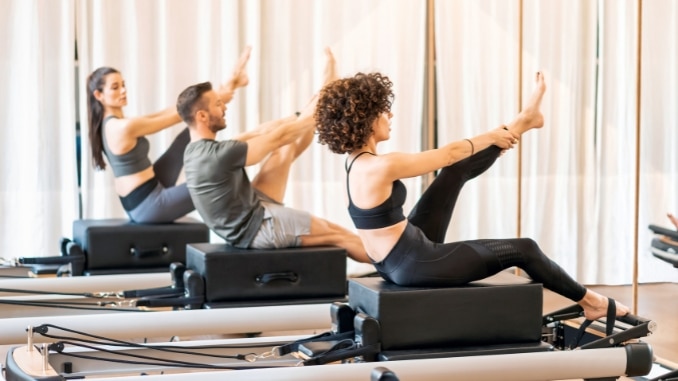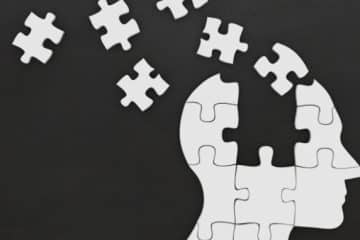Want toned and sculpted legs? Pilates leg exercises are a great way to strengthen and define your lower body, even for beginners. Let's learn 3 Must-Try Pilates leg exercises to tone and strengthen your legs!
“Pilates” helps make your tummy and lower back strong, which stabilizes your body and lets you move better. It's a trendy exercise method that combines being aware of your body with building strength and flexibility in muscles. People often do Pilates on mats without needing much equipment. It's used a lot for getting better after injuries and staying fit, and it helps your body and mind feel good by teaching you to control your body with your thoughts.
Pilates doesn't just make your core strong and help you focus better. It also works on other parts of your body. For example, there are Pilates exercises that really focus on making your legs stronger and more toned.
What is Leg Pilates?
Leg Pilates is a form of exercise that focuses on strengthening and toning the muscles in the legs using pilates principles[1]. Pilates, in general, emphasizes core strength, flexibility, and overall body awareness. In Leg Pilates, specific exercises and movements target the muscles in the legs.
Moreover, it often involves a combination of controlled movements, breath awareness, and alignment to improve muscle strength, flexibility, and balance in the lower body. By integrating these focused leg exercises into your Pilates routine, you can elevate your fitness objectives to a higher level.
Advantages of Pilates Leg Workouts
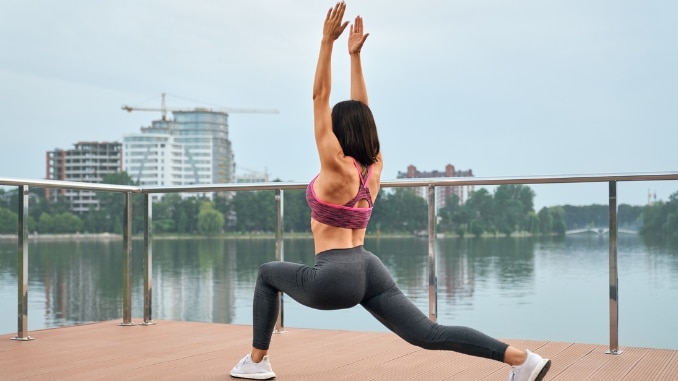
If you add these exercises to your regular workout routine, you can expect the following benefits:
- Muscle Tone: Pilates leg workouts carefully target particular muscle groups in your legs, such as the quadriceps, hamstrings, glutes, and calves. This focused involvement leads to a more toned and shaped lower body.
- Increased Strength and Endurance: Performing Pilates leg exercises gradually increases the strength of your leg muscles. This increased strength not only makes daily chores easier, but it also improves your entire sports performance.
- Increased Flexibility: Pilates leg routines require a balance of strength and flexibility. Regular repetition of these exercises adds to an increase in hip, knee, and ankle range of motion and flexibility.
- Improved Posture and Alignment: Many Pilates leg exercises focus on improving core stability, which leads to better overall posture and alignment. A higher stance and improved alignment are naturally promoted by strengthening your core and leg muscles.
- Injury Prevention: Because of their low-impact nature and tenderness on joints, Pilates leg movements are an ideal alternative for injury prevention. You may also reduce your risk of common lower body injuries by strengthening the muscles surrounding your knees and ankles.
Target Muscles of Pilates Leg Exercises
- Quadriceps: Located at the front of your thighs, the quadriceps are responsible for extending your knees and stabilizing your legs.
- Hamstrings: The hamstrings, found at the back of your thighs, are responsible for knee flexion and hip extension.
- Glutes: The gluteal muscles, including the gluteus maximus, medius, and minimus, are responsible for hip extension, rotation, and abduction. Strong glutes also contribute to a more stable and balanced lower body.
- Calves: The muscles in your calves, including the gastrocnemius and soleus, are responsible for plantar flexion, which is the action of pointing your toes.
- Hip Adductors: These muscles, located on the inner thighs, are responsible for bringing your legs together towards the midline of your body.
Proper Form and Technique for Pilates Leg Exercises
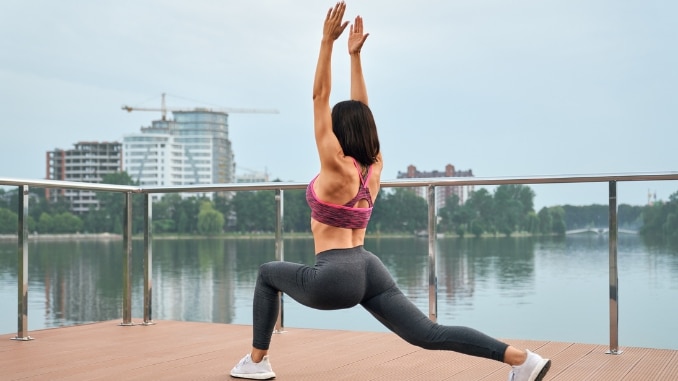
Body Positioning:
-
- Start by positioning your body correctly.
- Stand up straight with relaxed shoulders.
- Tighten your tummy muscles.
- Make sure your hips, knees, and ankles are in line.
Breathing:
-
- Learn how to breathe right in Pilates.
- Take a deep breath through your nose.
- Breathe out fully through your mouth.
- Match your breath to your movements to keep your core strong and steady.
Control and Accuracy:
-
- Focus on moving slowly and steadily.
- Don't rush or use fast movements.
- Be precise to work the right muscles effectively.
Core Strength:
-
- Understand how important your core is in Pilates leg exercises.
- Keep your belly muscles tight all the time.
- This helps support your lower back and keep you steady.
Adjustments:
-
- Change exercises if you need to, especially if you're new or have physical limits.
- Use different equipment or do alternative moves.
- Make the movements smaller or bigger depending on how fit you are.
- As you get stronger and more flexible, you can make things harder bit by bit.
3 Must-Try Pilates Leg Exercises for a Toned and Stronger Lower Body
1. Back Step with Arm Raises
Begin in an upright standing position, maintaining good alignment with your head, shoulders, hips, and legs. Engage your core and then take a big step back with one foot, keeping your toes pointing straight ahead. Bend your front knee directly over your ankle, creating a 90-degree angle from the body, and straighten your back leg. Extend both your arms overhead. Hold this position for several deep belly breaths, in through your nose and then out through your mouth. Return to the starting position and repeat the movement as needed.
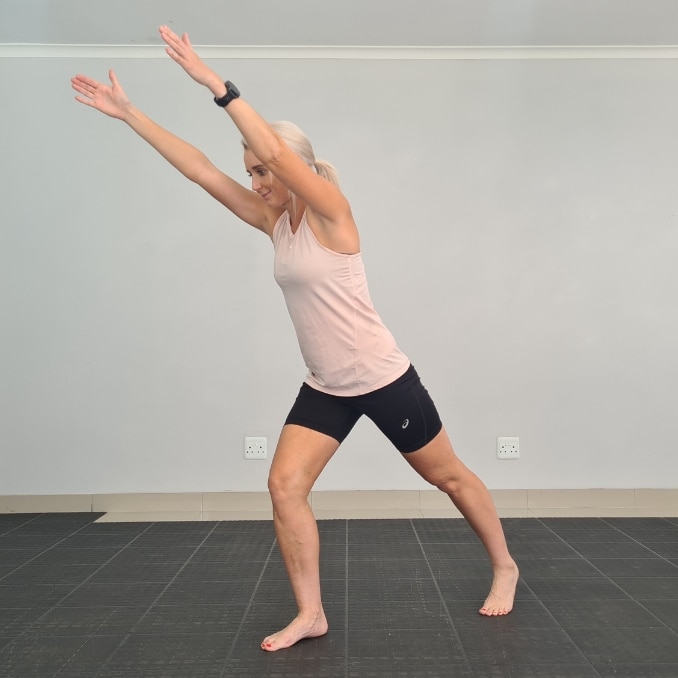
2. Fire Hydrants
Variation 1 – Fire Hydrants
For this exercise, utilize the use of a chair or a wall for support if needed.
Firstly, begin in an upright standing position, maintaining good alignment with your head, shoulders, hips, and legs. Place your one hand on the back of the chair or wall and the other on your hips. Engage your core. Secondly, lift your right leg, bring it out to the side together with your upper body, and begin moving your leg in a circular motion. Lastly, lower your leg back to the starting position and repeat the movement in the opposite direction.
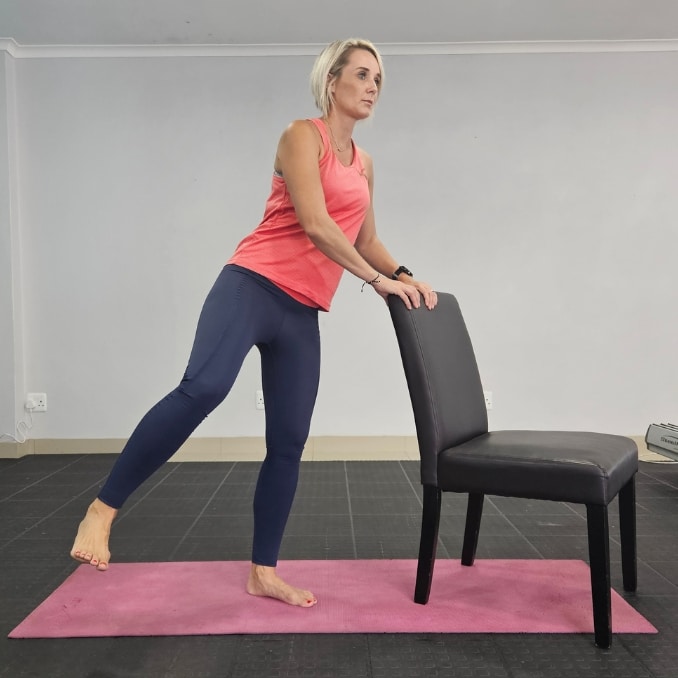 |
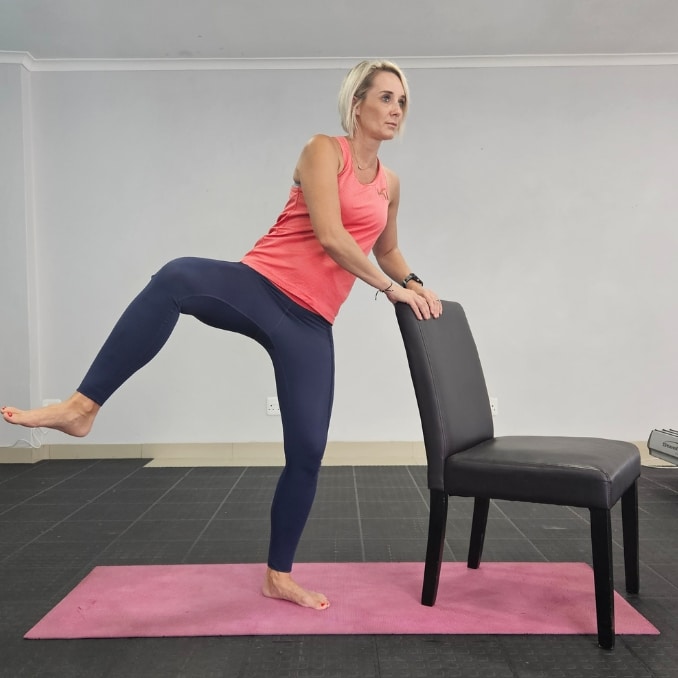 |
Variation 2 – Fire Hydrants
Begin in a 4-point position with your hands under your shoulders and your knees underneath your hips. After that, engage your core and lift your left leg, bringing one knee out to the side. Begin a sweeping circular motion in one direction. Lower your leg back to the starting position and then repeat the movement in the opposite direction.
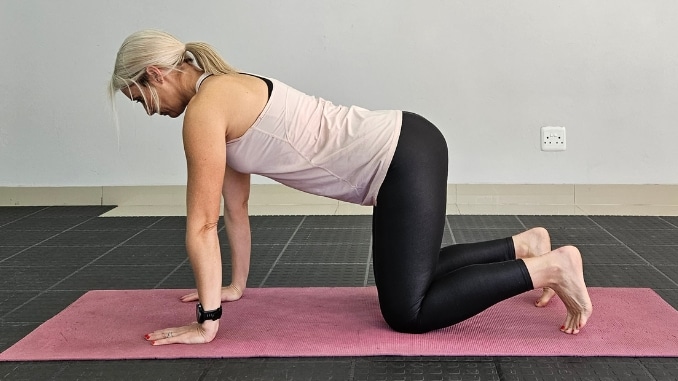 |
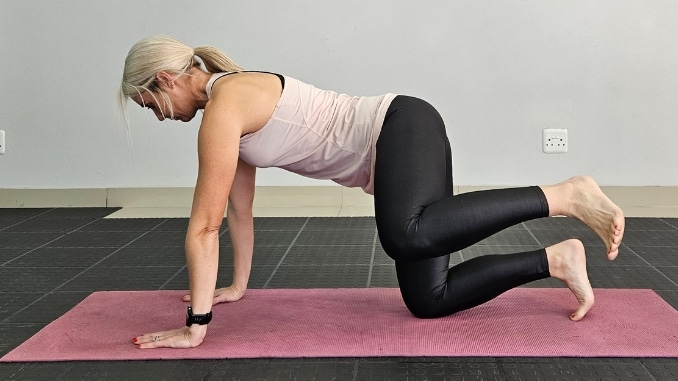 |
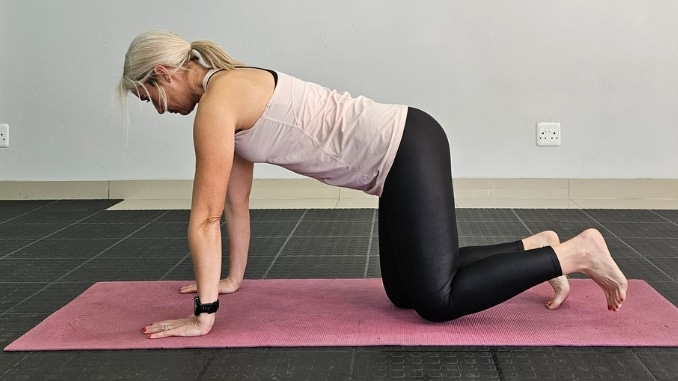 |
3. Squats
Begin in an upright standing position with your shoulder-width apart and your toes pointing forward. Engage your core, hinge from your hips, and bend your knees to lower your seat downward. Keep your knees behind your toes and do not let your knees fall inward. Hold this position for several deep belly breaths, in through your nose, and then out through your mouth. Press from your heels to return to the starting position and repeat the movement.
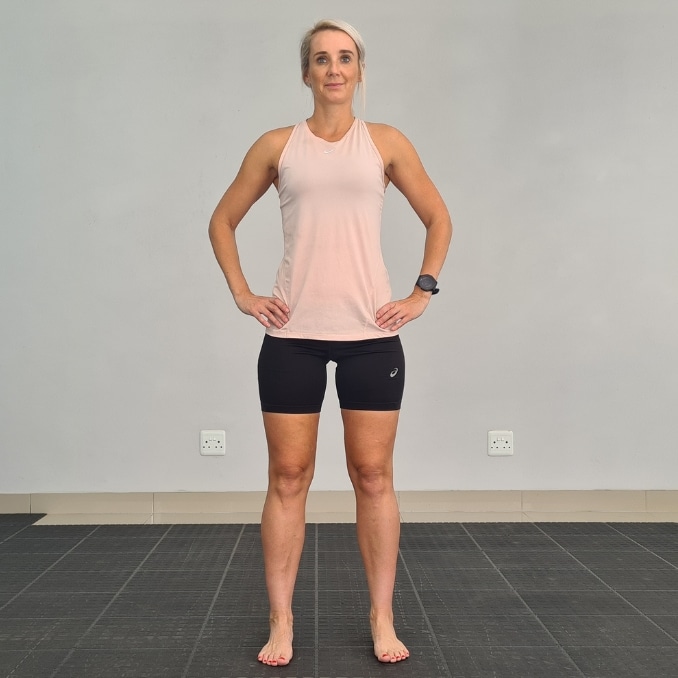 |
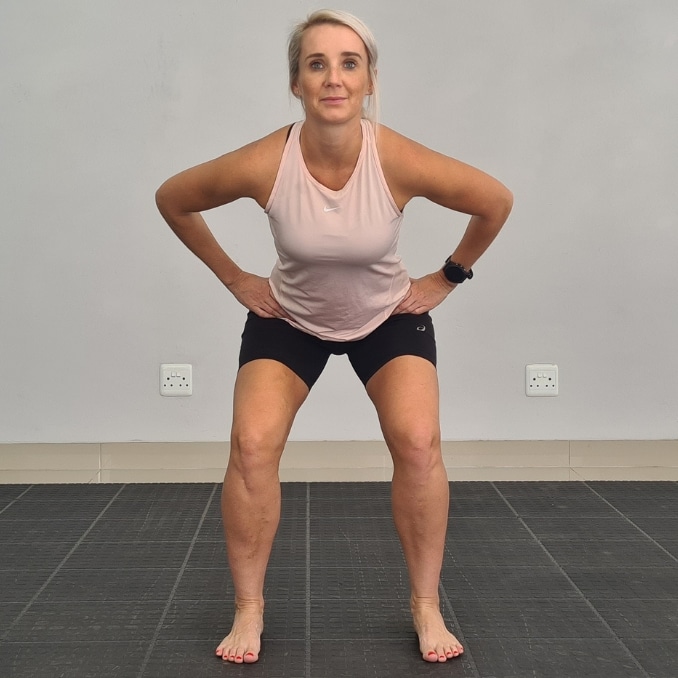 |
Variation 1 – Chair Squats
Begin in an upright standing position with your feet shoulder-width apart and your toes pointing forward. Engage your core, hinge from your hips, and bend your knees to lower your seat downward reaching the chair. Hold this position for several deep belly breaths, in through your nose, out through your mouth. Press from your heels to return to the starting position and then repeat the movement. Repeat the movement.
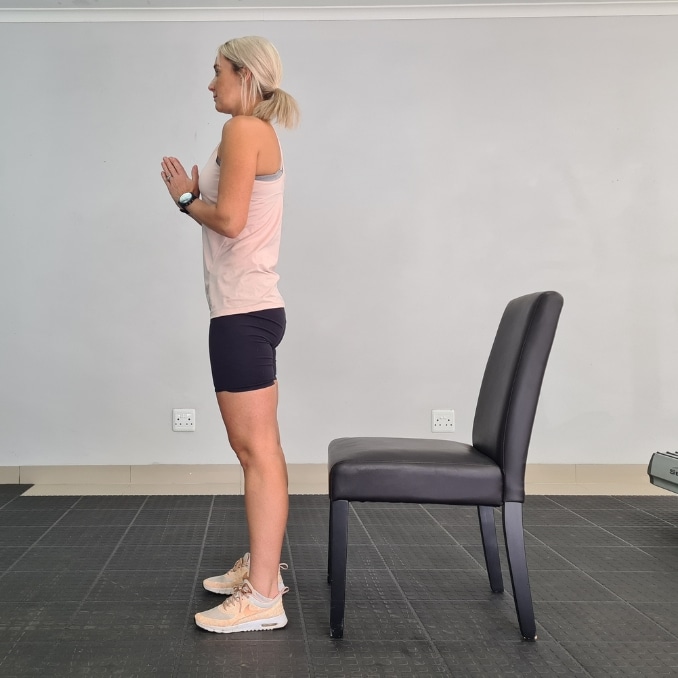 |
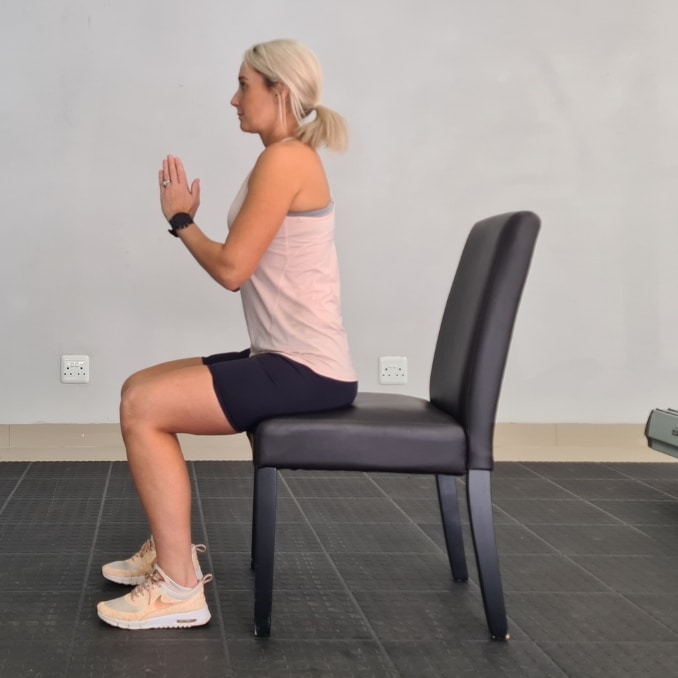 |
Variation 2 – Plie Squats
Begin in an upright standing position with your feet wider than shoulder-width apart and your toes pointing slightly outward. Engage your core, hinge from your hips, and bend your knees to lower your seat downward. Keep your knees behind your toes, and do not let your knees fall inward.
Hold this position for several deep belly breaths, in through your nose, and then out through your mouth. Press from your heels to return to the starting position and repeat the movement.
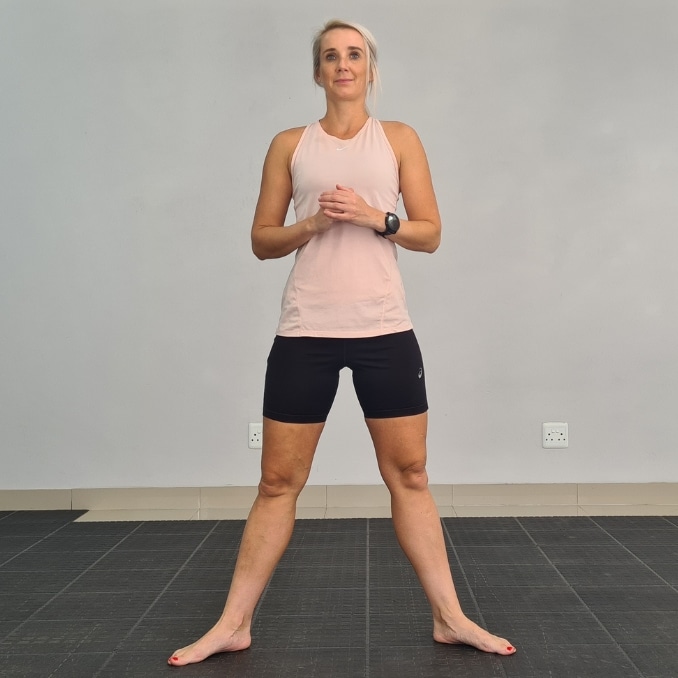 |
 |
Bonus Routine:
Side Leg Lift
Firstly, lie on your side, with your legs straight and left arm under your head, while the other is in the front of your belly. Maintain good alignment with your head, shoulders, hips, and feet. Secondly, engage your core and lift your right leg or your top leg towards the ceiling. Hold this position for several deep belly breaths, in through your nose and then out through your mouth. Lastly, gently lower down your leg, Return to the starting position, and repeat the movement.
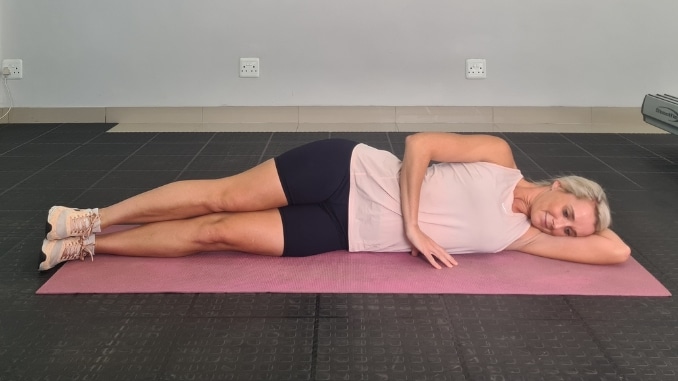 |
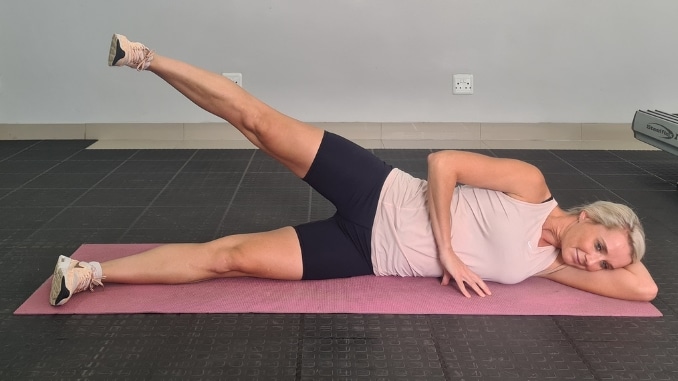 |
Conclusion: Elevating your Fitness Journey through Leg Pilates
A Science Direct study[2] found Pilates exercises boost flexibility, balance, and muscle endurance. Leg Pilates, a key part of Pilates, enhances endurance, flexibility, and balance, vital for overall fitness. Precise and controlled movements strengthen leg muscles, improve coordination, and fit with Pilates' focus on core strength and body awareness. Those who practice Pilates not only look better but also perform daily activities more effectively.
Everyone wants toned and shapely legs, but did you know that an impactful routine designed to tighten your thighs has lots of other benefits? So check out this Tone & Tighten Thigh Workout now!

